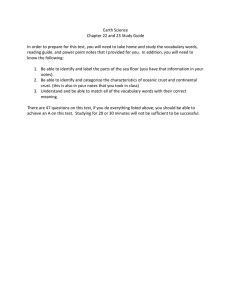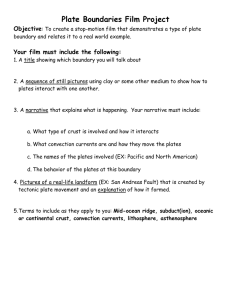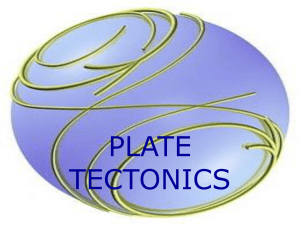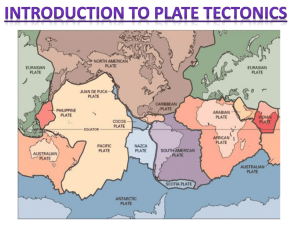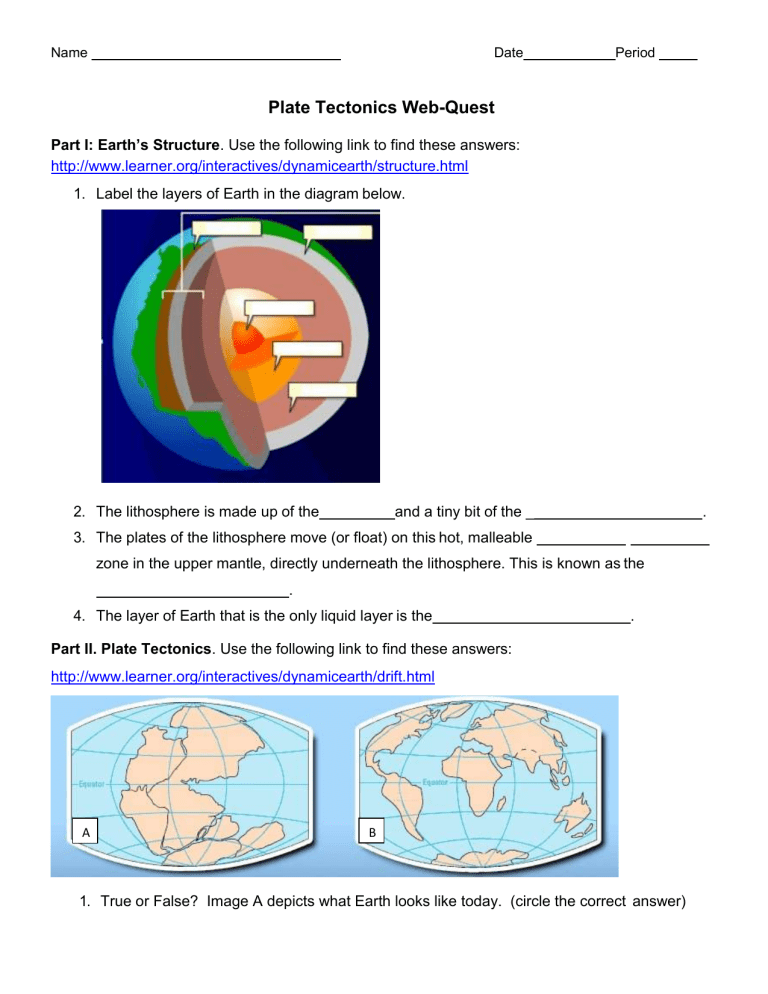
Name Date Period Plate Tectonics Web-Quest Part I: Earth’s Structure. Use the following link to find these answers: http://www.learner.org/interactives/dynamicearth/structure.html 1. Label the layers of Earth in the diagram below. 2. The lithosphere is made up of the and a tiny bit of the _ . 3. The plates of the lithosphere move (or float) on this hot, malleable zone in the upper mantle, directly underneath the lithosphere. This is known as the . 4. The layer of Earth that is the only liquid layer is the . Part II. Plate Tectonics. Use the following link to find these answers: http://www.learner.org/interactives/dynamicearth/drift.html A B 1. True or False? Image A depicts what Earth looks like today. (circle the correct answer) Name Date Period 2. What did Earth look like 250 million years ago? The continents of Earth were clustered together in formation that a scientist named . The scientist that named “Pangaea” was a German scientist by the name of . He theorized that “Pangaea" split apart and the different landmasses, or continents, drifted to their current locations on the globe. Wegener’s theories of plate movement became the basis for the development of the theory of . 3. Order the images of Earth’s plates in order from oldest or earliest (1) to most recent (5). Part III. Plates and Boundaries. Use the following link to find these answers: http://www.learner.org/interactives/dynamicearth/plate.html 1. Name the missing tectonic plates in the blanks on the image below. 2. The place where the two plates meet is called a . Boundaries have different names depending on how the two plates are moving in relationship to each other. A. If two plates are pushing towards each other it is called a . B. If two plates are moving apart from each other it is called a . Name Date Period C. If two plates are sliding past each other it is a called a . 3. Label the type of boundary depicted in each image below. 4. Plates and Boundaries Challenge. Follow directions for the challenge. Record your results below: Part I. Number of correctly placed plates = Part II. Number of boundary types correctly labeled = Part IV. Slip, Slide, and Collide. Use the following link to find these answers: http://www.learner.org/interactives/dynamicearth/slip.html 1. At convergent boundaries, tectonic plates with each other. The events that occur at these boundaries are linked to the types of plates (oceanic or ) that are interacting. Subduction Zones and Volcanoes At some convergent boundaries, an oceanic plate collides with a continental plate. Oceanic crust tends to be and than continental crust, so the denser oceanic crust gets bent and pulled under, or , beneath the lighter and thicker continental crust. This forms what is called a subduction zone. As the oceanic crust sinks, a deep oceanic , or valley, is formed at the edge of the continent. The crust continues to be forced deeper into the earth, where high heat and pressure cause trapped water and other gasses to be released from it. This, in turn, makes the base of the crust melt, forming . The magma formed at a subduction zone rises up toward the earth's surface and builds up in magma chambers, where it feeds and creates on the overriding plate. When this magma finds its way to Name Date Period the surface through a vent in the crust, the volcano erupts, expelling and . An example of this is the band of active volcanoes that encircle the Pacific Ocean, often referred to as the Ring of Fire. Roll your mouse over the image to find the definitions of the words below: Subduction Zone – Magma Trench Volcano Volcanic Arc Fill in the type of crust converging in the image below. A subduction zone is also generated when two oceanic plates collide — the older plate is forced under the one, and it leads to the formation of chains of volcanic islands known as . Collision Zones and Mountains What happens when two continental plates collide? Because the rock making up continental plates is generally lighter and less dense than oceanic rock, it is too light to get pulled under the earth and turned into magma. Instead, a collision between two continental plates crunches and folds the rock at the boundary, lifting it up and leading to the formation of . Name Date Period Fill in the type of crust converging in the image below. Roll your mouse over the image to find the definitions of the words below: Continental Crust Mountain - 2. At divergent boundaries, tectonic plates are moving from each other. One result of huge masses of crust moving apart is spreading. This occurs when two plates made of oceanic crust pull apart. A crack in the ocean floor appears and then magma oozes up from the mantle to fill in the space between the plates, forming a raised ridge called a forming When two . The magma also spreads outward, ocean floor and oceanic crust. plates diverge, a valley-like rift develops. This a dropped zone where the plates are pulling apart. As the crust widens and thins, valleys form in and around the area, as do , which may become increasingly active. Early in the rift formation, streams and rivers flow into the low valleys and long, narrow lakes can be created. Eventually, the widening crust along the divergent boundary may become thin enough that a piece of the continent breaks off, forming a new tectonic plate. is Name Date Period 3. At transform boundaries, tectonic plates are not moving directly toward or directly away from each other. Instead, two tectonic plates direction. This kind of boundary results in a past each other in a horizontal . A fault is a crack or in the earth's crust that is associated with this movement. Transform boundaries and the resulting faults produce many edges of tectonic plates are jagged rather than because . As the plates grind past each other, the jagged edges strike each other, catch, and stick, "locking" the plates in place for a time. Because the plates are locked together without moving, a lot of builds up at the fault line. This stress is released in quick bursts when the plates suddenly slip into new positions. The sudden movement is what we feel as the shaking and trembling of an earthquake. The motion of the plates at a transform boundary has given this type of fault another name, a . The best-studied strike-slip fault is the San Andreas Fault in . 4. Complete the Plate Interactions Challenge and Test Skills questions. My score for Plate Interactions Challenge = My score for Test Skills questions = out of 30 or % Name Date Period Part V. Questions you should be able to answer now that you completed this webquest. Note - you may go back to the website and review to assist in answering the following questions. 1. Deep-ocean and are created by convergent boundaries of ocean and continental crust. Convergent Boundary (ocean – continental) 2. Deep-ocean , , and are created by convergent boundaries of ocean and ocean crust. Convergent Boundary (ocean – ocean) 3. are created by convergent boundaries of continental and continental crust. Convergent Boundary (continental – continental) 4. Another type of boundary neither creates nor consumes crust. This type of boundary is called a boundary because two plates move against each other, building up tension, then release the tension is a sudden jerk of land called an . Name Date Period 4. Circle the correct type of boundary for each description below: A. The boundary where two plates meet and trenches are formed. Divergent Convergent Transform B. The plates move away from each other allowing magma to create new ocean crust. Divergent Convergent Transform C. The plates move in opposite directions building up tension until they slip causing earthquakes. Divergent Convergent Transform 5. Label each type of boundary as either: Divergent, Convergent, or Transform Boundary: A. B. C. The end. Please take a minute and look over your web-quest to make sure you answered all questions and completed all tasks. Make sure your name is on the front and turn it in.
